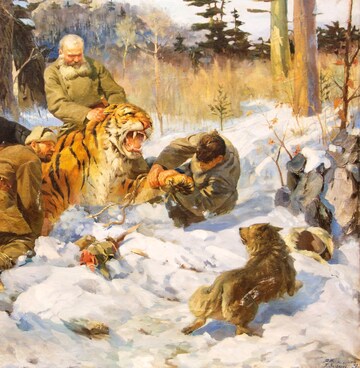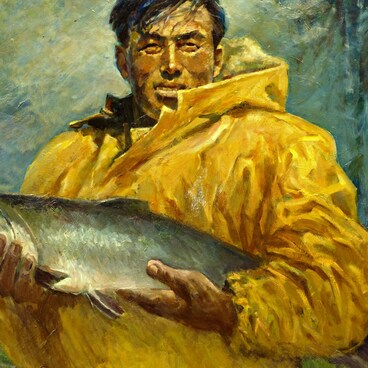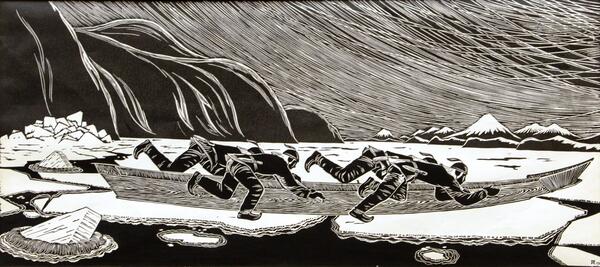Alexander Geyker (1933–2013) was the first Nanai painter to become a member of the Artists’ Union of the USSR.
Alexander Geyker was born in the Nanai village of Simasi into a family of a hunter. He had a profound connection with his people and a deep understanding of their way of life. The future artist was tutored by teachers from an art school and an art studio in Komsomolsk-on-Amur, including Dmitry Andreyevich Gutov, Yevgeny Vasilyevich Korolenko and Nikolay Pavlovich Dolbilkin. Geyker never received any special art education.
He was especially drawn to graphic art, which required a steady hand and a keen eye to manage its strict contrasts and precise lines and succeed at finding clear expressive angles and focusing on the main objectives without any excessiveness. Alexander Geyker used lino printing — a technique popular in the 1960s and 1970s — quite extensively.
His graphic works are based on displaying the lifestyle, traditions and customs of the Nanai people that have been carefully preserved amid the modern world — all the things that the artist saw and adopted in his own life ever since childhood.
In 1967, Alexander Geyker started participating in municipal and regional exhibitions, including those in Vladivostok (1974), Chita (1980), Komsomolsk-on-Amur (1983, dedicated to the city’s 50th anniversary) and Khabarovsk (2003). Between 1971 and 1972, his works were displayed in Moscow among the paintings of other artists from Siberia, the Russian Far East and the Urals. In 1973, Alexander Geyker presented a cycle of graphic works depicting the lifestyle and cultural life of the Nanai people, which gained him acceptance into the Artists’ Union of the USSR.
The artist was especially excited by the regional exhibition “The Soviet Far East” that took place in Ulan-Ude in 1969. There, two of his works were displayed — “Ice Drifting on the Amur” and “Sun over the Amur (Hurray for the Life!)”. The engraving “Sun over the Amur” is a landscape that has effortlessly incorporated the figure of a hunter. The hunter’s raised arms, his gun facing the floor, and long-necked birds flying toward the sun embody the principal idea of Geyker’s art vision — the triumph of life and the unity of people and nature.
Alexander Geyker was born in the Nanai village of Simasi into a family of a hunter. He had a profound connection with his people and a deep understanding of their way of life. The future artist was tutored by teachers from an art school and an art studio in Komsomolsk-on-Amur, including Dmitry Andreyevich Gutov, Yevgeny Vasilyevich Korolenko and Nikolay Pavlovich Dolbilkin. Geyker never received any special art education.
He was especially drawn to graphic art, which required a steady hand and a keen eye to manage its strict contrasts and precise lines and succeed at finding clear expressive angles and focusing on the main objectives without any excessiveness. Alexander Geyker used lino printing — a technique popular in the 1960s and 1970s — quite extensively.
His graphic works are based on displaying the lifestyle, traditions and customs of the Nanai people that have been carefully preserved amid the modern world — all the things that the artist saw and adopted in his own life ever since childhood.
In 1967, Alexander Geyker started participating in municipal and regional exhibitions, including those in Vladivostok (1974), Chita (1980), Komsomolsk-on-Amur (1983, dedicated to the city’s 50th anniversary) and Khabarovsk (2003). Between 1971 and 1972, his works were displayed in Moscow among the paintings of other artists from Siberia, the Russian Far East and the Urals. In 1973, Alexander Geyker presented a cycle of graphic works depicting the lifestyle and cultural life of the Nanai people, which gained him acceptance into the Artists’ Union of the USSR.
The artist was especially excited by the regional exhibition “The Soviet Far East” that took place in Ulan-Ude in 1969. There, two of his works were displayed — “Ice Drifting on the Amur” and “Sun over the Amur (Hurray for the Life!)”. The engraving “Sun over the Amur” is a landscape that has effortlessly incorporated the figure of a hunter. The hunter’s raised arms, his gun facing the floor, and long-necked birds flying toward the sun embody the principal idea of Geyker’s art vision — the triumph of life and the unity of people and nature.



